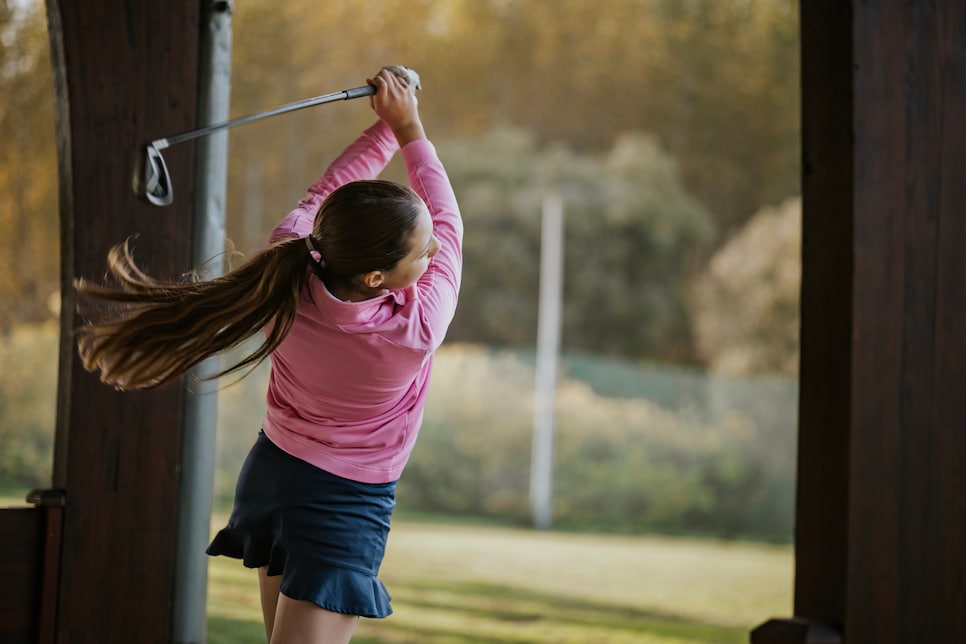If you feel like you’re seeing more women on the golf course than ever before, you’re right. According to the National Golf Foundation (NGF), a record 28 percent of all on-course golfers in 2024 were women. The total number of women golfers increased to nearly 8 million, marking the fifth consecutive year that the number of women playing golf has increased
The pandemic is a clear player in this story: Female participation in golf has increased by 2.3 million since 2019. And while questions persisted of whether the game would be able to keep all of these new golfers, the data shows that the game is retaining, and gaining, women golfers.
“Women are continuing to come to the game because of the programs facilities put into place during Covid and importantly continue to host for new golfers,” Sara Dickson, a Golf Digest Best Young Teacher at Wilderness C.C. in Naples. “Women’s golf culture is also booming—we’re seeing an uptick in women’s apparel and clubs both at the facility and from companies, and women’s golf culture has had an increased social media presence.”
When women come to golf, they’re finding more clothing options than have ever been available. They’re finding programming that’s low-stress. They’re finding community – not only in person, but online, too: From large social media accounts like Women Who Golf, which boasts 94,000 Facebook members and connects women in the game, to smaller local groups like the Indy Women’s Golf League.
Kendra Bishop created the Indy Women’s Golf League. The relatively new Instagram group that connects 20-30-year-old female golfers already has over a thousand followers. The players are of all levels, and some have found their way to this group because they’ve felt intimidated by more intense golf leagues. They play weekly, changing their location depending on how many players sign up and where those players are located.
“I do think golf is just becoming more inclusive and young women are gravitating into activities that they can do with friends and socials, and there’s less of a stigma. I do think it’s hard without a support group or trying to play on your own,” Bishop said.
A deeper look at the NGF’s findings is equally encouraging.

ProfessionalStudioImages
Junior Golfers
According to the NGF, 1,284,000 female juniors played golf in 2024, comprising 35 percent of all junior golfers. In 2000, that number was just 15 percent. Those figures bode well for the future of women’s golf: The NGF has found that avid junior golfers are very likely to turn into lifelong golfers.
Programs like PGA Junior League and LPGA USGA Girls Golf make golf fun, focusing on team play and group learning. LPGA USGA Girls Golf clinics started in 1989 and have now had more than one million girls go through the program. One of the keys to their programming is that they have created the opportunity for girls to learn how to play alongside other girls. According to their research, “Junior golf programs that offer girls-only programming experience a 50% higher retention rate than those who do not.”
When girls start playing golf now, they’re not the only girl in a clinic full of boys. There are more girls than ever to connect with. Here, we’re seeing a compounding effect: More girls play the game because more girls are playing the game.
Off-Course Golfers 
Jupiterimages
Another area of growth is off-course golf, played at venues like Topgolf and on golf simulators. According to the NGF, 8.2 million women played off-course golf in 2024, which increases their chances of taking up the game for real. According to the NGF, someone who doesn’t play golf but has hit a golf ball at an off-course location like Topgolf is five times more interested in playing golf on-course compared to someone who’s never hit a ball at a golf entertainment hub.
Latent Demand
The NGF keeps track of people who have never played golf, but are interested. They found that there are more than 7 million women who are “very interested” in playing golf. They call this ‘Latent Demand’ and women make up 35 percent of the 24.1 million Americans who are “very interested” in playing golf.
Combine interest with easy access and a welcoming environment, and we could see a number of interested women turn into on-course golfers.
It might just be the environment itself that’s changed the most and enabled more women to join and stay in golf.
“We have given our industry a very hard time about not being inclusive enough, and I believe all of our efforts to diversify the game have created more avenues for women to come into the game,” Molly Braid, a Golf Digest Best Young Teacher and Best in State Teacher out of Wisconsin, says. Her club, Westmoor C.C. has seen increased female engagement in lessons and golf schools, as well as nine-hole and social events.
Women are coming to golf from different backgrounds, for different reasons. Once they’ve arrived, they’re feeling more welcome than ever. And because that’s changed, the number of women who join the game will likely only continue to increase.
This article was originally published on golfdigest.com



